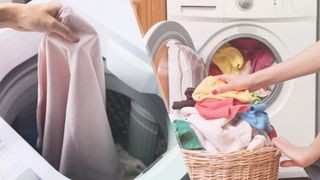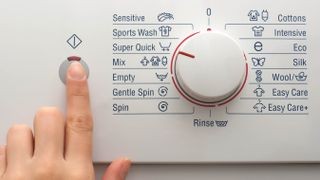Which Washing Machine Guide is essential for anyone looking to purchase a new appliance, ensuring you select the best washing machine that meets your needs and budget. CONDUCT.EDU.VN offers comprehensive guidance, helping you navigate through various models, features, and technologies to make an informed decision. Explore our detailed guides to find the perfect laundry solution, considering factors like energy efficiency, load capacity, and smart features.
1. Front Load vs. Top Load: Making the Right Choice
The first major decision when buying a washing machine is whether to choose a front load or top load model. Both designs have their advantages and disadvantages, catering to different user preferences and needs. Understanding these differences is crucial for making the right choice.
1.1 Front Load Washers: Advantages and Disadvantages
Front load washers are known for their superior cleaning performance, energy efficiency, and gentle handling of clothes. They use a tumbling action to clean clothes, which is more effective and less abrasive than the agitator in top load washers.
Advantages:
- Superior Cleaning: Front load washers generally provide better cleaning results due to their tumbling action and efficient use of water.
- Energy Efficiency: These washers use less water and energy compared to top load models, leading to lower utility bills.
- Gentle on Clothes: The tumbling action is gentler on clothes, reducing wear and tear and prolonging the life of your garments.
- Stackable Design: Many front load washers can be stacked with a matching dryer, saving space in your laundry area.
Disadvantages:
- Higher Initial Cost: Front load washers tend to be more expensive than top load models.
- Longer Cycle Times: Wash cycles can be longer compared to top load washers.
- Bending Required: Loading and unloading clothes requires bending down, which may be inconvenient for some users.
- Potential for Mold Growth: The airtight seal can trap moisture, leading to mold and mildew growth if not properly maintained.
1.2 Top Load Washers: Advantages and Disadvantages
Top load washers are more traditional and often more affordable. They come in two main types: those with a central agitator and those with a impeller plate. Agitator models use a central post to move clothes through the water, while impeller models use a low-profile disc on the bottom of the drum to create a swirling action.
Advantages:
- Lower Initial Cost: Top load washers are generally less expensive than front load models.
- Faster Cycle Times: Wash cycles are typically shorter compared to front load washers.
- Easier Loading: Loading and unloading clothes is easier as it doesn’t require bending down.
- Ability to Add Clothes Mid-Cycle: Some top load washers allow you to add clothes even after the cycle has started.
Disadvantages:
- Less Energy Efficient: Top load washers typically use more water and energy than front load models.
- Harsher on Clothes: The agitator can be rough on clothes, leading to more wear and tear.
- Smaller Capacity: Top load washers may have a smaller capacity compared to front load models.
- Less Effective Cleaning: The cleaning performance may not be as effective as front load washers, especially for heavily soiled items.
2. Capacity: Choosing the Right Size for Your Needs
Capacity refers to the amount of laundry a washing machine can handle in a single load, measured in cubic feet. Choosing the right capacity is essential for efficiency and convenience.
2.1 Understanding Washing Machine Capacity
Washing machine capacity ranges from small portable models around 2.0 cubic feet to extra-large models exceeding 5.0 cubic feet. The ideal capacity depends on your household size and washing habits.
- Small (2.0 – 3.0 cubic feet): Suitable for individuals or couples with light laundry needs.
- Medium (3.5 – 4.5 cubic feet): Ideal for small families or those who wash a moderate amount of laundry.
- Large (4.5 – 5.5 cubic feet): Perfect for families with children or those who wash bulky items like comforters and blankets.
- Extra-Large (5.5+ cubic feet): Best for large families or those who frequently wash large loads of laundry.
2.2 Tips for Choosing the Right Capacity
- Consider Your Household Size: The larger your family, the greater capacity you will need.
- Think About Bulky Items: If you frequently wash bulky items, opt for a larger capacity model.
- Avoid Overloading: Overloading the washing machine can reduce its cleaning performance and damage the appliance.
- Check the Manufacturer’s Recommendations: Refer to the manufacturer’s guidelines for load sizes to ensure optimal performance.
| Capacity (cubic feet) | Ideal Household Size | Typical Laundry Needs |
|---|---|---|
| 2.0 – 3.0 | Individual/Couple | Light loads, occasional washing |
| 3.5 – 4.5 | Small Family | Moderate loads, regular washing |
| 4.5 – 5.5 | Family | Large loads, frequent washing, bulky items |
| 5.5+ | Large Family | Very large loads, frequent washing, bulky items |
3. Spin Speed: Maximizing Drying Efficiency
Spin speed, measured in revolutions per minute (RPM), determines how much water is extracted from clothes during the final spin cycle. Higher spin speeds reduce drying time, saving energy and time.
3.1 Understanding Spin Speed
Spin speed typically ranges from 800 to 1600 RPM. Higher spin speeds are more effective at removing water, but they can also be harsher on delicate fabrics.
- 800 – 1000 RPM: Suitable for delicate fabrics and lighter loads.
- 1000 – 1200 RPM: Ideal for everyday laundry and mixed loads.
- 1200 – 1400 RPM: Perfect for towels, jeans, and other heavy fabrics.
- 1400 – 1600 RPM: Best for maximizing water extraction and reducing drying time.
3.2 Choosing the Right Spin Speed
- Consider Fabric Types: Use lower spin speeds for delicate fabrics and higher spin speeds for durable fabrics.
- Check the Care Label: Follow the manufacturer’s instructions on the care label for recommended spin speeds.
- Adjust as Needed: Adjust the spin speed based on the load size and fabric types to achieve optimal results.
4. Energy Efficiency: Saving Money and the Environment
Energy efficiency is a crucial factor to consider when buying a washing machine. Energy-efficient models use less water and electricity, saving you money on utility bills and reducing your environmental impact.
4.1 Understanding Energy Efficiency Ratings
The Energy Star label is a reliable indicator of energy efficiency. Washing machines with the Energy Star label meet strict energy efficiency guidelines set by the U.S. Environmental Protection Agency (EPA).
- Energy Star Certified: These models are typically 10-20% more energy-efficient than standard models.
- Water Factor: This measures the amount of water used per cycle per cubic foot of capacity. Lower water factors indicate greater water efficiency.
- Modified Energy Factor (MEF): This measures the energy efficiency of the washing machine. Higher MEF values indicate greater energy efficiency.
4.2 Tips for Choosing Energy-Efficient Models
- Look for the Energy Star Label: Choose models with the Energy Star label to ensure optimal energy efficiency.
- Compare Water Factors: Opt for models with lower water factors to save water.
- Check the MEF Value: Select models with higher MEF values to save energy.
- Consider Eco Settings: Look for washing machines with eco settings that use less water and energy.
5. Noise Level: Minimizing Disruption
The noise level of a washing machine can be a significant factor, especially if you live in an apartment or have young children. Look for models with noise reduction technology to minimize disruption.
5.1 Understanding Noise Ratings
Noise levels are typically measured in decibels (dB). Lower decibel ratings indicate quieter operation.
- 40 – 50 dB: Very quiet operation, suitable for apartments and homes with noise sensitivities.
- 50 – 60 dB: Moderate noise level, acceptable for most households.
- 60+ dB: Louder operation, may be disruptive in quiet environments.
5.2 Tips for Choosing Quiet Washing Machines
- Look for Noise Reduction Technology: Choose models with features like vibration reduction and sound insulation.
- Check the Noise Rating: Opt for models with lower decibel ratings for quieter operation.
- Read Customer Reviews: Check customer reviews for feedback on noise levels.
- Consider Placement: Place the washing machine on a level surface to minimize vibrations and noise.
6. Wash Cycles and Settings: Versatility for Different Fabrics
The variety of wash cycles and settings is essential for handling different types of fabrics and laundry needs. Look for models with a wide range of options to ensure optimal cleaning and care.
6.1 Common Wash Cycles and Settings
- Normal/Regular: For everyday laundry and mixed loads.
- Delicate/Gentle: For delicate fabrics like silk, lace, and lingerie.
- Permanent Press: For wrinkle-resistant fabrics and synthetic blends.
- Heavy Duty: For heavily soiled items like jeans, towels, and work clothes.
- Quick Wash: For lightly soiled items that need a quick refresh.
- Sanitize: For killing bacteria and germs on items like baby clothes and bedding.
- Bulky/Bedding: For washing large items like comforters, blankets, and pillows.
- Eco/Energy Saver: For saving water and energy on lightly soiled items.
6.2 Tips for Choosing the Right Wash Cycles
- Consider Your Laundry Needs: Choose a model with cycles that match the types of fabrics you wash most often.
- Look for Specialty Cycles: If you have specific needs, like washing baby clothes or heavily soiled items, look for models with specialty cycles.
- Read the Manual: Refer to the manufacturer’s manual for detailed information on each cycle and its recommended use.
- Experiment with Settings: Experiment with different settings to find the best combination for your laundry needs.
7. Automatic Detergent Dispenser: Convenience and Efficiency
An automatic detergent dispenser automatically measures and dispenses the correct amount of detergent for each load, saving you time and preventing overuse.
7.1 How Automatic Dispensers Work
Automatic detergent dispensers typically consist of a reservoir that holds liquid or powder detergent. The washing machine automatically draws detergent from the reservoir based on the load size and soil level.
7.2 Benefits of Automatic Dispensers
- Convenience: Saves time and effort by eliminating the need to measure detergent for each load.
- Efficiency: Prevents overuse of detergent, saving money and reducing residue on clothes.
- Accuracy: Dispenses the correct amount of detergent for optimal cleaning performance.
- Reduced Waste: Minimizes detergent spills and waste.
7.3 Tips for Using Automatic Dispensers
- Use High-Efficiency (HE) Detergent: Use only HE detergent in automatic dispensers to prevent oversudsing.
- Follow the Manufacturer’s Instructions: Refer to the manufacturer’s manual for instructions on filling and maintaining the dispenser.
- Clean the Dispenser Regularly: Clean the dispenser regularly to prevent clogs and buildup.
- Adjust as Needed: Adjust the detergent level based on the load size and soil level.
8. Smart Features: Connectivity and Control
Smart washing machines offer a range of connected features, allowing you to control and monitor the appliance remotely via your smartphone or other smart devices.
8.1 Common Smart Features
- Remote Start: Start the washing machine remotely from your smartphone.
- Cycle Monitoring: Monitor the progress of the wash cycle from your smartphone.
- Downloadable Cycles: Download additional wash cycles for specific fabrics or needs.
- Self-Diagnosis: Diagnose potential problems with the washing machine and receive troubleshooting tips.
- Energy Monitoring: Track energy consumption and adjust settings to save energy.
- Voice Control: Control the washing machine with voice commands via smart assistants like Amazon Alexa or Google Assistant.
8.2 Benefits of Smart Features
- Convenience: Control the washing machine from anywhere with your smartphone.
- Information: Receive real-time information on cycle progress and energy consumption.
- Customization: Download additional cycles and customize settings to meet your needs.
- Troubleshooting: Diagnose and resolve potential problems quickly and easily.
- Energy Savings: Monitor and adjust energy consumption to save money and reduce your environmental impact.
8.3 Tips for Using Smart Features
- Download the App: Download the manufacturer’s app to access smart features.
- Connect to Wi-Fi: Connect the washing machine to your home Wi-Fi network.
- Explore the Features: Explore the app and familiarize yourself with the available features.
- Customize Settings: Customize settings to meet your needs and preferences.
- Keep the App Updated: Keep the app updated to ensure optimal performance and access to the latest features.
9. Stackable Design: Saving Space
If you have limited space in your laundry area, consider a stackable washing machine and dryer. Stackable models allow you to stack the dryer on top of the washing machine, saving valuable floor space.
9.1 Benefits of Stackable Design
- Space Saving: Saves valuable floor space in small laundry areas.
- Convenience: Easy access to both the washer and dryer.
- Aesthetic Appeal: Creates a clean and organized look in the laundry room.
9.2 Tips for Choosing Stackable Models
- Check Compatibility: Ensure that the washing machine and dryer are compatible for stacking.
- Purchase a Stacking Kit: Purchase a stacking kit from the manufacturer to ensure stability and safety.
- Follow the Instructions: Follow the manufacturer’s instructions for proper installation.
- Consider Pedestals: Consider adding pedestals under the washing machine and dryer for added height and storage.
10. Size and Dimensions: Ensuring a Proper Fit
Before buying a washing machine, measure the space where you plan to install it to ensure a proper fit. Consider the width, depth, and height of the washing machine, as well as the space needed for ventilation and access.
10.1 Tips for Measuring Your Space
- Measure the Width: Measure the width of the space to ensure that the washing machine will fit comfortably.
- Measure the Depth: Measure the depth of the space to ensure that the washing machine will not protrude too far into the room.
- Measure the Height: Measure the height of the space to ensure that there is enough clearance for the washing machine, especially if you plan to stack it with a dryer.
- Consider Ventilation: Ensure that there is adequate ventilation around the washing machine to prevent overheating.
- Allow for Access: Allow enough space for easy access to the washing machine for loading and unloading laundry.
10.2 Standard Washing Machine Dimensions
- Width: 27 inches
- Depth: 30-34 inches
- Height: 38-40 inches
11. Customer Reviews: Insights from Other Users
Before making a purchase, read customer reviews to get insights from other users about the washing machine’s performance, reliability, and features.
11.1 Where to Find Customer Reviews
- Online Retailers: Check customer reviews on online retailers like Amazon, Best Buy, and Home Depot.
- Manufacturer’s Website: Visit the manufacturer’s website to read customer reviews and testimonials.
- Consumer Reports: Consult Consumer Reports for unbiased reviews and ratings.
- Forums and Communities: Join online forums and communities to discuss washing machines and read reviews from other users.
11.2 Tips for Evaluating Customer Reviews
- Read a Variety of Reviews: Read a variety of reviews to get a balanced perspective.
- Look for Recurring Themes: Look for recurring themes or issues that are mentioned in multiple reviews.
- Consider the Source: Consider the source of the review and whether it is biased.
- Focus on Performance and Reliability: Focus on reviews that discuss the washing machine’s performance, reliability, and features.
- Take Reviews with a Grain of Salt: Remember that customer reviews are subjective and may not reflect your own experience.
12. Maintenance and Care: Ensuring Longevity
Proper maintenance and care are essential for ensuring the longevity and performance of your washing machine. Follow these tips to keep your washing machine in top condition.
12.1 Regular Cleaning
- Clean the Drum: Clean the drum regularly with a washing machine cleaner or a mixture of vinegar and baking soda to remove buildup and odors.
- Clean the Dispenser: Clean the detergent dispenser regularly to prevent clogs and buildup.
- Clean the Door Seal: Clean the door seal regularly to prevent mold and mildew growth.
- Wipe Down the Exterior: Wipe down the exterior of the washing machine with a damp cloth to keep it clean and free of dust.
12.2 Proper Usage
- Avoid Overloading: Avoid overloading the washing machine to prevent damage and ensure optimal cleaning performance.
- Use the Right Detergent: Use the right type and amount of detergent for each load.
- Follow the Instructions: Follow the manufacturer’s instructions for proper usage and maintenance.
- Check Pockets: Check pockets for coins, keys, and other items that could damage the washing machine.
12.3 Preventative Maintenance
- Check Hoses: Check hoses regularly for leaks and cracks.
- Level the Washing Machine: Ensure that the washing machine is level to prevent vibrations and noise.
- Clean the Lint Filter: Clean the lint filter regularly to prevent clogs and ensure proper drainage.
- Schedule Professional Maintenance: Schedule professional maintenance every year or two to ensure that the washing machine is in top condition.
13. Understanding Washing Machine Warranties
A washing machine warranty protects you against defects in materials and workmanship. Understanding the terms and conditions of the warranty is crucial for ensuring that you are covered in case of a problem.
13.1 Types of Warranties
- Limited Warranty: Covers specific parts and labor for a specific period.
- Extended Warranty: Extends the coverage of the original warranty for an additional period.
- Full Warranty: Covers all parts and labor for a specific period.
13.2 Key Warranty Considerations
- Coverage Period: How long the warranty lasts.
- What is Covered: Which parts and repairs are covered.
- Exclusions: What is not covered by the warranty.
- Deductibles: Any out-of-pocket expenses you may incur.
- Claim Process: How to file a warranty claim.
13.3 Tips for Warranty Management
- Read the Warranty Carefully: Understand the terms and conditions of the warranty.
- Keep Records: Keep records of your purchase date, model number, and warranty information.
- Register Your Product: Register your washing machine with the manufacturer to activate the warranty.
- Follow Maintenance Guidelines: Follow the manufacturer’s maintenance guidelines to avoid voiding the warranty.
- File Claims Promptly: File warranty claims promptly if you experience a problem with your washing machine.
14. Addressing Common Washing Machine Problems
Even with proper maintenance, washing machines can experience problems. Knowing how to address common issues can save you time and money.
14.1 Common Problems and Solutions
- Washing Machine Won’t Start:
- Check the power cord and outlet.
- Ensure the door is properly closed.
- Check the circuit breaker.
- Washing Machine Won’t Drain:
- Check the drain hose for kinks or clogs.
- Clean the drain pump filter.
- Ensure the drain hose is properly connected.
- Washing Machine is Leaking:
- Check the water inlet hoses for leaks.
- Ensure the drain hose is properly connected.
- Check the door seal for damage.
- Washing Machine is Noisy:
- Ensure the washing machine is level.
- Check for loose items in the drum.
- Inspect the motor and pump for damage.
- Washing Machine Smells Bad:
- Clean the drum with a washing machine cleaner.
- Clean the detergent dispenser.
- Leave the door open after each use to allow the drum to air dry.
14.2 When to Call a Professional
- If you are unable to diagnose or resolve the problem yourself.
- If the problem involves electrical components or internal mechanisms.
- If the washing machine is still under warranty.
15. New Technologies in Washing Machines
Washing machine technology is constantly evolving, with new features and innovations designed to improve performance, efficiency, and convenience.
15.1 Key Technological Advancements
- Steam Cleaning: Uses steam to sanitize and remove stains from clothes.
- Ozone Cleaning: Uses ozone gas to kill bacteria and odors without detergent.
- Adaptive Wash Technology: Automatically adjusts wash settings based on the load size and soil level.
- Inverter Motors: Provide quieter and more energy-efficient operation.
- Smart Dispensers: Automatically dispense the correct amount of detergent and fabric softener.
- Wi-Fi Connectivity: Allows you to control and monitor the washing machine remotely.
15.2 Benefits of New Technologies
- Improved Cleaning Performance: Advanced technologies like steam and ozone cleaning provide better stain removal and sanitization.
- Increased Efficiency: Features like adaptive wash technology and inverter motors save water and energy.
- Enhanced Convenience: Smart dispensers and Wi-Fi connectivity make laundry tasks easier and more convenient.
- Quieter Operation: Inverter motors and noise reduction technology provide quieter operation.
16. Budget Considerations: Finding the Best Value
The cost of a washing machine can vary widely, depending on the brand, features, and capacity. Setting a budget and finding the best value is crucial for making a smart purchase.
16.1 Factors Affecting Cost
- Type: Front load washers are typically more expensive than top load models.
- Capacity: Larger capacity washing machines tend to be more expensive.
- Features: Advanced features like steam cleaning, smart dispensers, and Wi-Fi connectivity can increase the cost.
- Brand: Some brands are known for higher quality and performance, which can command a premium price.
- Energy Efficiency: Energy-efficient models may have a higher upfront cost but can save you money in the long run.
16.2 Tips for Finding the Best Value
- Set a Budget: Determine how much you are willing to spend on a washing machine.
- Compare Prices: Shop around and compare prices from different retailers.
- Look for Sales and Discounts: Take advantage of sales, discounts, and rebates.
- Consider Refurbished Models: Consider buying a refurbished washing machine to save money.
- Read Reviews: Read customer reviews to assess the performance and reliability of different models.
17. Top Washing Machine Brands
Several brands are known for producing high-quality, reliable washing machines. Researching different brands can help you narrow down your options and find the best model for your needs.
17.1 Popular Brands
- Samsung: Known for innovative features and stylish designs.
- LG: Offers a wide range of models with advanced technologies.
- Whirlpool: A trusted brand with a long history of producing reliable appliances.
- Maytag: Known for durable and powerful washing machines.
- GE: Offers a variety of models with energy-efficient features.
- Bosch: Known for high-quality and energy-efficient washing machines.
17.2 Brand Comparison
| Brand | Key Features | Target Audience |
|---|---|---|
| Samsung | Innovative features, stylish designs, smart technology | Tech-savvy consumers, modern homes |
| LG | Advanced technologies, wide range of models, energy efficiency | Families, eco-conscious consumers |
| Whirlpool | Reliable performance, durable construction, user-friendly features | Traditional households, budget-minded |
| Maytag | Powerful cleaning, heavy-duty construction, robust performance | Heavy users, demanding environments |
| GE | Energy efficiency, versatile models, reliable performance | Eco-conscious consumers, families |
| Bosch | High-quality construction, energy efficiency, quiet operation | Luxury homes, apartment dwellers |
18. The Impact of Washing Machines on Society
Washing machines have had a profound impact on society, transforming the way we care for our clothes and impacting our daily lives.
18.1 Historical Perspective
- Early Washing Machines: The first washing machines were manual devices that required significant physical effort.
- Electric Washing Machines: The introduction of electric washing machines in the early 20th century revolutionized laundry tasks.
- Modern Washing Machines: Today’s washing machines are highly advanced, with features like automatic dispensers, smart technology, and energy-efficient operation.
18.2 Social and Economic Impact
- Time Savings: Washing machines have saved countless hours of manual labor, freeing up time for other activities.
- Improved Hygiene: Washing machines have improved hygiene by making it easier to clean clothes and bedding.
- Economic Growth: The washing machine industry has created jobs and contributed to economic growth.
- Women’s Empowerment: Washing machines have reduced the burden of household chores, empowering women to pursue education and careers.
19. Future Trends in Washing Machines
The future of washing machines is likely to be shaped by new technologies, changing consumer needs, and a growing focus on sustainability.
19.1 Emerging Trends
- Artificial Intelligence (AI): AI-powered washing machines will be able to learn your laundry habits and automatically adjust wash settings.
- Internet of Things (IoT): Washing machines will be integrated into the Internet of Things, allowing you to control and monitor them from anywhere.
- Waterless Washing: Waterless washing technologies will use alternative methods like compressed air or ultrasonic waves to clean clothes.
- Sustainable Materials: Washing machines will be made from sustainable materials and designed for easy recycling.
- Personalized Laundry Solutions: Washing machines will be customized to meet the specific needs of individual users.
19.2 Implications for Consumers
- Increased Convenience: New technologies will make laundry tasks even easier and more convenient.
- Improved Performance: Advanced features will provide better cleaning and stain removal.
- Greater Sustainability: Eco-friendly washing machines will help reduce your environmental impact.
- Lower Costs: Energy-efficient models and smart features will save you money on utility bills.
20. Finding the Perfect Washing Machine: A Summary
Choosing the right washing machine involves considering various factors, including type, capacity, spin speed, energy efficiency, noise level, wash cycles, smart features, and budget. By understanding your needs and researching your options, you can find the perfect washing machine for your home.
20.1 Key Considerations
- Assess Your Needs: Determine your laundry needs, household size, and budget.
- Research Different Models: Read reviews and compare features to find the best washing machine for your needs.
- Consider Energy Efficiency: Choose an energy-efficient model to save money and reduce your environmental impact.
- Check Customer Reviews: Read customer reviews to assess the performance and reliability of different models.
- Read the Warranty: Understand the terms and conditions of the warranty.
20.2 Final Thoughts
Investing in a high-quality washing machine can make laundry tasks easier, more efficient, and more enjoyable. By following the tips and guidelines in this guide, you can find the perfect washing machine for your home and enjoy years of reliable performance.
Navigating the world of washing machines can be overwhelming, but with the right information, you can make an informed decision. CONDUCT.EDU.VN is committed to providing you with the most comprehensive and up-to-date resources to help you choose the best washing machine for your needs. Our expert guides and detailed reviews empower you to confidently select an appliance that fits your lifestyle and budget.
Are you struggling to find reliable information and clear guidance on washing machine selection? At CONDUCT.EDU.VN, we simplify the process with detailed guides and expert advice tailored to your specific needs.
Visit CONDUCT.EDU.VN today to explore our comprehensive resources and find the perfect washing machine for your home. For personalized assistance, contact us at 100 Ethics Plaza, Guideline City, CA 90210, United States, or reach out via WhatsApp at +1 (707) 555-1234. Let conduct.edu.vn help you make the right choice!






